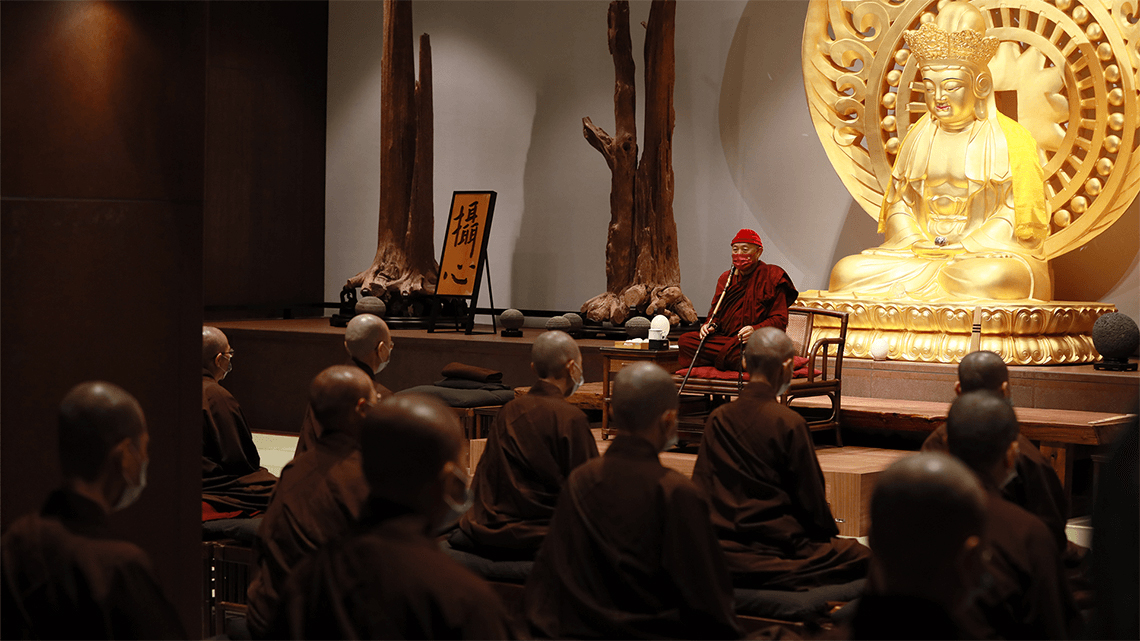The Ling Jiou Mountain 10-Day Autumn Retreat 2021: Letting Go of All Clingings for the Original Spirituality to Emerge

The purpose of the Vassa during Buddha's time was for the sanghas to make progress in their Dharma practice during the monsoon season when travel was difficult so that more energy could be (re-)stored to benefit oneself and others when performing Dharma duties and tasks for sentient beings, and the promotion of Dharma would thus become widespread as manifested by the sanghas. Chan T’ang, or meditation hall, is also known as the ‘Venue of Buddha's Picks’ and it is where sanghas meditate to achieve enlightenment and realize the Ultimate Truth. The hall serves the purpose of attaining Buddhahood by way of enlightenment so that sentient beings can liberate themselves from wanton ideas of ego-centrism, worries, attachments, and other delusions by practicing meditation of certain Dharma methodology right there in the meditation hall.
The LJM Water-Land Dharma Assembly 2021 also offered the platform for a 21-day online retreat and it was almost like a pilgrimage for all participants. The physical toils were rewarded with an internal purification that became a source of bliss and joy. It worked as a pre-trip visit to the in-person retreat to further firm up one's mindfulness. Dharma Master Hsin Tao said that ‘... a retreat is, by definition, to isolate all things external for the mind to stay clearly aware and constraints-free so that both the delusions and the truth become self-evident. The 49-day retreat adjacent to the lunar Chinese New Year provides a longer period of time to extend our progress in meditative absorption. Actually, a proper retreat is one on the level of mindfulness or to nurture and cultivate a habit of having mindfulness as our constant companion. This year's 10-day autumn retreat is a good one in the sense that we realize our inherent awareness never once disappeared. Instead, it has always been clearly self-illuminating.
Chan/Zen Buddhism adopts a direct approach to the mind, and Buddhahood is attained the moment the original nature is comprehended in full. However, the real emphasis lies with the practice of meditation in daily life. Master Hsin Tao therefore expects his disciples and followers to make long strides of progress by practicing meditation retreats every year, returning the mind to spirituality no matter how crowded the schedules are for promoting Buddhism. Put differently, the Master expects followers to learn and employ clear-cut and focused ways to see through to one's nature and return to the nature that is entirely cut off from thoughts and concerns. The Master further hopes that sanghas and followers alike will excel at accumulating proof of evidence via meditative realization for more future reserves when spreading Buddha's teachings to liberate sentient beings.
Dharma Master Hsin Tao reminds followers to let go of thoughts and ideas and to live good days without haste nor stress. “As long as the awareness remains non-phenomenal, it returns to the original nature at the end. Phenomena are all external changes of appearances, and we are best advised to let go of all thoughts and ideas to let our mind rest upon our awareness, relaxed and comfortable. Do not allow yourselves to be pulled by wandering ideas in all directions. Instead, live good days and days that aren't at capacity. Not over-crowded means that your days may be physically demanding, yet your heart and mind stay poised at all times.”
Master Hsin Tao further encourages followers to work hard and strive for solid progress, in that “each and every idea can be a complicated study of genetics. The singularly most important element of meditation consists of śamatha (calm) and vipaśyanā (mindfulness) - the former calms thoughts and ideas and returns us back to mindfulness, back to the focus of breathing, and the four procedures of Chan/Zen meditation the LJM way. We ought to get into the habit of having mindfulness for a constant companion so much so that it becomes an integral part of all our actions in walking, stopping, sitting, and reclining.”